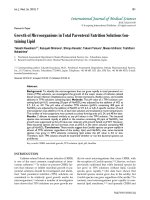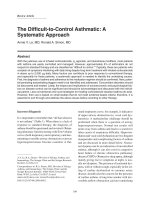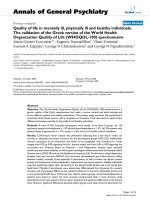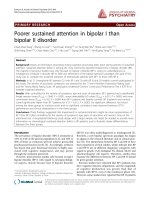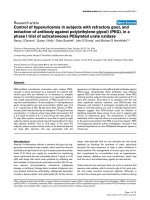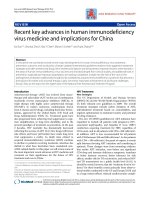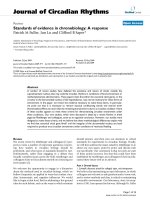Báo cáo y học: " Invasive ventilation modes in children: a systematic review and meta-analysis" doc
Bạn đang xem bản rút gọn của tài liệu. Xem và tải ngay bản đầy đủ của tài liệu tại đây (338.53 KB, 8 trang )
RESEARCH Open Access
Invasive ventilation modes in children:
a systematic review and meta-analysis
Anita Duyndam, Erwin Ista
*
, Robert Jan Houmes, Bionda van Driel, Irwin Reiss, Dick Tibboel
Abstract
Introduction: The purpose of the present study was to critically review the existing body of evidence on
ventilation modes for infants and children up to the age of 18 years.
Methods: The PubMed and EMBASE databases were searched using the search terms ‘artificial respiration’,
‘instrumentation’, ‘device’, ‘devices’, ‘mode’, and ‘modes’. The review included only studies comparing two
ventilation modes in a randomized controlled study and reporting one of the following outcome measures: length
of ventilation (LOV), oxygenation, mortality, chronic lung disease and weaning. We quantitatively pooled the results
of trials where suitable.
Results: Five trials met the inclusion criteria. They addressed six different ventilation modes in 421 children: high-
frequency oscillation (HFO), pressure control (PC), pressure support (PS), volume support (VS), volume diffusive
respirator (VDR) and biphasic positive airway pressure. Overall there were no significant differences in LOV and
mortality or survival rate associated with the different ventilation modes. Two trials compared HFO versus
conventional ventilation. In the pooled analysis, the mortality rate did not differ between these modes (odds ratio =
0.83, 95% confidence interval = 0.30 to 1.91). High-frequency ventilation (HFO and VDR) was associated with a better
oxygenation after 72 hours than was conventional ventilation. One study found a significantly higher PaO
2
/FiO
2
ratio
with the use of VDR versus PC ventilation in children with burns. Weaning was studied in 182 children assigned to
either a PS protocol, a VS protocol or no protocol. Most children could be weaned within 2 days and the weaning
time did not significantly differ between the groups.
Conclusions: The literature provides scarce data for the best ventilation mode in critically ill children beyond the
newborn period. There is no evidence, however, that high-frequency ventilation reduced mortality and LOV.
Longer-term outcome measures such as pulmonary function, neurocognitive development, and cost-effectiveness
should be considered in future studies.
Introduction
Ventilator-induced lung injury in critically ill children
suf fering from acute respiratory failure should be coun-
teracted by adaptin g ventilation management t o the
cause of respiratory failure [1]. Ideally, management
should be based on proven effective strategies. In a mul-
ticenter study, bro nchiolitis was the most frequent cause
of respiratory failure in infants (43.6%); pneu monia the
most frequent cause in older children (24.8%) [2]. Mor-
tality in that study was rare (1.6%); the median duration
of ventilation was 7 days. Randolph suggested that in
pediatric clinical trials long-term morbidity would be a
more sensitive indicator of the effects of clinical ventila-
tion interventions than would mortality or duration of
ventilation [1].
Pediatric intensive care units worldwide use a wide
variety of ventilation modes: high-f requency oscillatio n
(HFO), pressure control (PC), synchronized intermittent
mandatory ventilation, pressure support (PS), pressure-
regulated volume control and, more recently, neurally
adjusted ventilator assist [3 ,4]. The ventilation mode is
often not targeted specifically to the underlying disease
but rather is determined by the intensive care physi-
cian’s experience, local pediatric intensive care unit pol-
icy and protocols, or outcomes of studies in adults
[1,2,5]. An unambiguous international guideline is still
lacking [1,5].
* Correspondence:
Intensive Care Unit, Erasmus MC - Sophia Children’s Hospital, PO Box 2060,
3000 CB Rotterdam, The Netherlands
Duyndam et al. Critical Care 2011, 15:R24
/>© 2011 Duyndam et al.; licensee BioMed Central Ltd. This is an Open Access article distributed under the terms of the Creative
Commons Attribution License (http://creativecommons. org/licenses/by/2.0), which permits unrestricted use, distribution, and
reproduction in any medium, provided the original work is properly cited.
The objective of the present article is to systematically
review the randomized controlled trials (RCTs) compar-
ing ventilation modes used in criticall y ill children (from
term born up to 18 years of age) on the following out-
come measures: length of ventilation, oxygenatio n, mor-
tality, chronic lung disease and weaning. We aimed to
determine whether there is sufficient evidence to decide
on the better mode.
Materials and methods
Search and selection
A systematic search was performed in the PubMed and
EMBASE databases in September 2010. MeSH terms
and keywords searched for in the titles, abstracts and
keywords areas were ‘artifici al respiration’, ‘instrumenta-
tion’, ‘device’, ‘devices’, ‘mode’,and‘modes’,combined
with the Boolean operators AND, OR. (Additional file 1
provides the complete search strategy.) The search was
limited to RCTs or quasi-experimental studies, with age
limit >28 days until 18 years. Only articles comparing at
least two vent ilation modes we re selected for review .
Articles on non-invasive ve ntilation, studies in prema-
ture neonates (< 37 weeks) and articles in other lan-
guages than English or Dutch were excluded. No limits
were imposed on the publication date.
Two authors (AD, EI) independently reviewed
abstracts and ful l-text articles to identify eligible st udies.
Reference lists of retrieved studies were hand-searched
for additional articles.
Quality assessment
The study quality and level of evidence were assessed on
criteria established by the Dutch Institute for Healthcare
Improvement CBO in collaborati on with the Dutch
Cochrane library (see Additional file 2 and Table 1) [6].
The major criteria were as follows: Was assignment to
the study group randomized? Were investigators
blind ed? Was it an intent ion-to-treat analysis? Were the
study groups comparable? Was there appropriate report
of outcome results for e ach group and the estimated
effect size? Consensus between the authors on the inter-
pretation of the extracted data was achieved.
Data abstraction
Authors AD and EI each independently recorded patient
characteristics (sample size, age, respiratory failure),
details of the ventilation mode and the period over
which outcome variables were measured. O utcome vari-
ables considered were the following: length of ventila-
tion (LOV), oxygenation, chronic lung disease, mortality
and weaning.
Statistical methods
We quantitatively pooled the results of individual trials,
where suitable. We expressed the treatment effect as an
odds ratio (OR) for dichotomous outco mes and as a
weighted mean difference (WMD) for continuous out-
comes with 95% confidence intervals (CIs). The pooled
OR was estimated with the Mantel-Haenszel method,
which is generally the most robust model [7]. Differ-
ences were considered stat istically significant if P <0.05
or if the 95% confidence interval did not include the
value 1. The analyses were performed with Microsoft
®
Excel, Office 2007 for Windows.
Results
Search and selection
After filtering out duplicate studies, the t itles and
abstracts of 461 potentially relevant articles were
screened (Figure 1). The reference lists y ielded one
other study that had been missed because the keywords
were not in the title or abstract. Eventually, nine full-
text articles were retrieved and assessed for eligibility.
Four RCTs were excluded for any of the following rea-
sons: fo cus on triggering instead of ventilation, inclusion
of infants below 37 weeks of gestational age, or not
comparing two ventilation modes [8-11]. The present
review therefore includes five RCTs [12-16].
Tabulated details of these five RCTs are presented in
Tables 2 and 3.
Table 1 Level of evidence
Level Description of evidence
1++ High-quality meta-analyses, systematic reviews of RCTs, or RCTs with a very low risk of bias
1+ Well-conducted meta-analyses, systematic reviews of RCTs, or RCTs with a low risk of bias
1- Meta-analyses, systematic reviews of RCTs, or RCTs with a high risk of bias
2++ High-quality systematic reviews of case-control or cohort studies; or high-quality case-control or cohort studies with a very low risk of
confounding, bias, or chance and a high probability that the relationship is causal
2+ Well-conducted case-control or cohort studies with a low risk of confounding, bias, or chance and a moderate probability that the
relationship is causal
2- Case-control or cohort studies with a high risk of confounding, bias or chance, and a significant probability that the relationship is not causal
3 Non-analytic studies; for example, case reports, case series
4 Expert opinion
RCT, randomized controlled trial.
Duyndam et al. Critical Care 2011, 15:R24
/>Page 2 of 8
Length of ventilation
The LOV served as the outcome measure in four studies
(Table 2). First, Arnold and colleagues in a multicenter
trial compared HFO and conventional ventilation (CV)
in 58 children with either diffuse alveolar disease and/or
air leak syndrome; 29 h ad been randomized to HFO,
and 29 to CV [12]. During the first 72 hours of study,
themeanairwaypressurewassignificantly(P <0.001)
higher in the HFO group. The HFO strategy entailed
aggressive increases in mean airway pressure to attain
the ideal lung volume and to achieve an arterial oxygen
saturation >90% with FiO
2
<0.6.TheCVstrategy
entailed stepping up the end-expirator y pressure and
inspiratory time to increase the mean airway pressure
and to limit peak inspiratory pressure increases. Cross-
over to the alternate ventilator was required if the
patient met defined criteria for treatment failure. LOV
did not significantly differ between the CV and HFO
groups (WMD = 2.0 days, 95% CI = -9.61 to 13.61).
Second, Dobyns and colleagues in a multicenter study
compared HFO and CV in 99 children with acute
hypoxemic respiratory failure [14]. Seventy-three children
were treated with CV (38 without inhaled nitric oxide
(iNO), 35 with iNO), and 26 with HFO (12 without iNO,
14 with iNO). Mechanical ventilation and FiO
2
were
adjusted to maintain SaO
2
at 90% and pCO
2
between 45
Figure 1 Search results. RCT, randomized controlled trial.
Duyndam et al. Critical Care 2011, 15:R24
/>Page 3 of 8
Table 2 Included randomized controlled trials - ventilation
Reference Study population Intervention/mode Outcome measures Level of
evidence
Mortality/survival LOV (days) Oxygenation CLD
Arnold and
colleagues
[12]
58 children (age: HFO
2.5 ± 2.5 vs. CV 3.1 ±
3.3 years) with diffuse
alveolar disease and/or
airleak syndrome
Multicenter study (five
centers)
Number of survivors at 30 days -
CV: 17 of 29 (59%); HFO: 19 of
29 (66%) (NS)
Total - CV: 22 ±
17; HFO: 20 ±
27
PaO
2
/PAO
2
increase over time (72 hours) in
HFO compared with CV (P < 0.001)
CV: n = 10 (59%);
HFO: n = 4 (21%) (P
= 0.039; OR = 5.4
95% CI = 1.2 to
23.2) (O
2
at 30 days)
1+
Comparison effectiveness of
HFO (n = 29) with CV (n =
29) - crossover
Death (ranked) - CV: 40%, CV to
HFO: 42%, HFO: 6%, HFO to CV:
82% (P ≤0.001)
Survivors (at 30
days) - CV: 29 ±
18; HFO: 27 ±
31.
PaO
2
/PAO
2
- HFO: 0.13 (0 hours) up to 0.26
(72 hours); CV: 0.13 (0 hours) up to 0.22 (72
hours)
Crossover: CV to HFO (n =
19), HFO to CV (n = 11)
Nonsurvivors (at
30 days) - CV: 11
± 9; HFO: 8 ± 6
(NS)
After crossover - PaO
2
/PAO
2
increase over
time (72 hours) in CV to HFO group
compared with HFO to CV group (P =
0.003)
Dobyns
and
colleagues
[14]
99 children (age 0 to
23 years) with AHRF,
oxygenation index >15
Multicenter study (seven
centers)
Trend of improved survival in
HFO + iNO - CV: 22 of 38 (58%);
CV + iNO: 20 of 35 (53%); HFO:
7 of 12 (58%); HFO + iNO: 10 of
14 (71%) (P=0.994)
CV: 22 ± 4; CV +
iNO: 21 ± 3;
HFO: 52 ± 28;
HFO + iNO: 17
±4(P = 0.098)
PaO
2
/FiO
2
(PF) ratio - after 4 hours: HFO +
iNO 136 ± 21 vs. CV 96 ± 6 (P = 0.2); after
12 hours: HFO + iNO 184 ± 45 vs. CV 107 ±
8 and CV + iNO 115 ± 9, HFO 136 ± 32 (P
= 0.023); after 24 hours: treatment both
HFO + iNO and HFO resulted in greater
improvement in PF ratio than CV or CV +
iNO (P = 0.005); after 72 hours: HFO 259 ±
60 vs. CV 148 ± 15 and CV + iNO 150 ± 19;
HFO + iNO 213 ± 29 (P = 0.027)
1+
Comparisons between
patients treated with HFO +
iNO (n = 14), HFO alone (n
= 12), CV + iNO (n = 35),
and CV alone (n = 38)
Jaarsma
and
colleagues
[13]
18 children (age 0 to
10 years) with
respiratory failure for
ventilation
Single-center study ND BIPAP: 9.8 ± 9.2;
PS: 6.4 ± 5.8 (P
= 0.27)
ND 1-
Compare BIPAP (n = 11)
with PS (n = 7), determining
which mode is effective,
safe and easy
Carman
and
colleagues
[16]
64 children (age 7.4 ±
0.7 years) with
inhalation injury
Single-center study VDR: 2/32 (6%); PC: 5/32 (16%)
(NS)
VDR: 12 ± 2;
PCV: 11 ± 2 (NS)
PF ratio - VDR: 563 ± 16; PC: 507 ± 13 (P <
0.05)
1-
Compare VDR (n = 32) with
PC (n = 32)
Data presented as number/total (percentage) or mean ± standard deviation. AHRF, acute hypoxemic respiratory failure; BIPAP, biphasic positive airway pressure; CI, confidence interval; CLD, chronic lung disease; CV,
conventional mechanical ventilation; HFO, high-frequency oscillation ventilation; iNO, inhaled nitric oxide; LOV, length of ventilation; ND, no data; NS, not significant; OR; odds ratio; VDR, volume diffusive respirator
(high-frequency time-cycled pressure ventilator); PC, pressure-controlled ventilation; PS, pressure support ventilation.
Duyndam et al. Critical Care 2011, 15:R24
/>Page 4 of 8
and 55 mmHg. Higher pCO
2
values were tolerated as
long as the arterial pH was 7.20. In the CV strategy, the
positive end-expiratory pressure was increased incremen-
tally to improve oxygenation while avoiding clinical and
radiographic signs of lung hyperinfl ation. The peak air-
way pressure was maintained at <35 to 40 cmH
2
Oby
limiting the level of tidal volume and positive end-expira-
tory pressure. The initial HFO settings were: FiO
2
of 1.0,
33% inspiratory time, frequency of 10 Hz, and mean air-
way pressure set at 2 to 4 cmH
2
Oabovethatusedon
CV. The pressure amplitude was set to achieve percepti-
ble chest wall motion and was adjusted if possible to
optimize ventilation. In this study HFO did not lead to a
significantly shorter LOV (Table 2). For the two ventila-
tion groups without iNO, however, the LOV significantly
differed between CV and HFO (WMD = -30.0 days, 95%
CI = -45.89 to -14.11).
Third, Carman and colleagues compared the volume
diffusive respirator (VDR) with PC ventilation in burned
children with inhalation injury [16]. The VD R is a high-
frequency, time-cycled pressure ventilator that can ven-
tilate, oxygenate and promote secretion removal. SaO
2
was maintained at or above 90%; PaCO
2
was maintained
at <55 mmHg. Thirty-two children with a mean ± stan-
dard deviation age of 5.5 ± 0.9 years were treated with
VDR, and 32 children with a mean ± standard deviation
age of 9.4 ± 1.0 years were trea ted with PC ventilation
(P = 0.04 for mean age). The LOV was significantly dif-
ferent between the study groups (WMD = -1.0 days,
95% CI = -1.98 to -0.02).
Fourth, Jaarsma and colleagues randomized 18 chil-
dren with respiratory failure to either biphasic positive
airway pressure (n = 11) or pressure support ventilation
(n = 7); their median age was 4 months (range 4 weeks
to 10 years) [13]. Initial ventilator settings depended on
age and the cause of respiratory failure, and were
adjusted according to thoracic excursions and t he mea-
sured tidal volume. Adjustments were made afterwards
aiming at a pCO
2
of 4 to 5 kPa and a pO
2
of 8 to
11 kPa. The LOV did not significantly differ between
biphasic positive airway pressure (9.8 ± 9.2 days) and PS
(6.4 ± 5.8 days).
Pooled analysis of these trials resulted in a signifi-
cantly shorter LOV after CV in comparison with HFO
(WMD = -2.3 days, 95% CI = -3.63 to -1.04) (Table 4).
Oxygenation
Three studies addressed the effects of dif ferent ventila-
tion modes on oxygenation.
In the study by Dobyns and colleagues, the PaO
2
/FiO
2
(PF) ratio improved most in the HFO mode with iNO
after 4 hours (136 ± 21 mmHg vs. CV 96 ± 6 mmHg;
P = 0.2) and after 12 hours (HFOV + iNO 184 ± 4 5
mmHg vs. CV 107 ± 8 mmHg and CV + iNO 115 ± 9
mmHg, P = 0.023; HFOV 136 ± 32 mmHg) [14]. After
24 hours, HFO treatment both with and without iNO
provided better oxygenation than CV both with and with-
out iNO (P < 0.05). After 72 hours, HFO treatment was
ass ociated with the best improvement in PF ratio (HFO
259 ± 60 mmHg vs. CV 148 ± 15 mmHg and CV + iNO
150 ± 19 mmHg, P = 0.027; HFOV + iNO 213 ±
9 mmHg). The two therapies did not differ in failure rate.
Arnold and colleagues reported a significant (P = 0.001)
relationship between time and a decreasing oxygenation
index in the HFO group but not in the CV group [12].
Aftercrossover(19patientscrossedoverfromCVto
HFO and 11 patients crossed over from HFO to CV) this
relationship was significant in both crossover groups (P =
0.03 crossover to CV; P = 0.02 crossover to HFO).
Carman and colleagues reported a significantly higher
PF ratio in the VDR mode compared with PC (563 ±
15 mmHg vs. 507 ± 13 mmHg, P <0.05)butdidnot
specify the time point at which the best PF ratio was
measured [1 6]. As the oxygenation para meters in these
three studies were not uniform it was not possible to
pool the data.
Table 3 Included randomized controlled trials- weaning
Reference Study population Intervention/mode Outcome measures Level of
evidence
Duration of
weaning
(days)
a
Extubation failure rate Oxygenation
Randolph
and
colleagues
[15]
182 children (age 0 to 17
years) with weaning of
ventilation support for more
than 24 hours and who
failed a test for extubation
readiness on minimal PS
Multicenter study (10 centers)
to evaluate weaning
protocols comparing VS
(continuous automated
adjustment of PS by the
ventilator) (n = 59) and PS
(adjustment by clinicians) (n =
61) with standard care (no
protocol) (n = 59)
PS: 1.6 (0.9 to
4.1); VS: 1.8 (1.0
to 3.2); no
protocol: 2.0
(0.9 to 2.9) (P
= 0.75)
PS (15%), VS (24%); no
protocol (17%) (P = 0.44).
Male children more
frequently failed extubation
(OR = 7.86 95% CI = 2.36 to
26.2; P < 0.001)
ND 1++
a
Data presented as median (interquartile range). CI, confidence interval; ND, no data; OR, odds ratio; PS, pressure support; VS, volume support.
Duyndam et al. Critical Care 2011, 15:R24
/>Page 5 of 8
Mortality and survival
Three studies focused on the outcome measure of mor-
tality or survival.
None found a significant difference in mortality
between patients treated with HFO and those treated
with CV. Arnold and colleagues repor ted a mortality
rate of 34% (10/29) for HFO versus 41% (12/29) for CV
(OR = 0.75, 95% CI = 0.26 to 2.16) [12]. The mortality
rate in patients not crossed over to CV from HFO or to
HFO from CV, however, was significantly better (P =
0.003) than that in patients managed with CV only.
Dobyns and colleagues showed that the survival rate
for patients treated with HFO in combination with iNO
was higher than that for patients treated with HFO only
or with CV (71% vs. 58% in CV, 53% in CV + iNO and
58% in HFO) [14]. These differences did not achieve sta-
tistical significance. These authors speculated that the
improved lung recruitment by HFO enhances the effects
of low-dose iNO on gas exchange. The mortality rate
for HFO without iNO was 42% (5/12) versus 42 % (16/
38) for CV without iNO (OR = 0.98, 95% CI = 0.26 to
3.66) [14]. In t he study by Carman and colleagues, five
outof32(16%)patientsinthePCVgroupdiedversus
two out of 32 (6%) in the VDR group (OR = 0.36, 95%
CI = 0.06 to 2.01) [16].
In the pooled analysis, the mortality rates in the HFO
mode and in CV did not differ ( OR = 0 .70, 95% CI =
0.33 to 1.47) (Table 5).
Chronic lung disease
Chronic lung disease was examined only in the study by
Arnold and colleagues [12]. The proportion of patient s
treated with HFO and requiring supplemental oxygen at
30 days was lower than that of patients managed with
CV (P = 0.039; OR = 5.4, 95% CI = 1.2 to 23.2).
Weaning
Randolph and colleagues randomized 182 children aged
from 0 to 17 years to either a PS protocol (n = 62), a
volumesupport(VS)protocol(n = 60) or a no ventila-
tion weaning protocol in which weaning was at the
discretion of the physician (n = 60) (Table 3) [15]. The
VS and PS protocols dictated that FiO
2
and positive
end-expiratory pressure be adjusted to maintain SpO
2
at
95% or higher. In the PS protocol, the amount of pres-
sure support was adjusted to achieve an exhaled tidal
volume goal of 5 to 7 ml/kg. In the VS protocol, the
ventilator automatically adjusted the level of PS to
achieve an exhaled tidal volume of 5 to 7 ml/kg.
Two outcome measures were assessed: weaning time
and extubation failure (that is, any invasive or non-invasive
ventilator support within 48 hours of extubation). The
authors hypothesized that VS would result in a shorter
weaning time as the inspiratory pressures automatically
decrease with improvement of lung compliance. Most
children could be weaned with in 2 days and the weaning
time did not significantly differ for the protocols used: PS,
1.6 days; VS, 1.8 days; an d no protocol, 2.0 days. Extuba-
tion failure rates were not significantly different for PS
(15%), VS (24%) and no protocol (17%).
Quality of studies
These five studies compared six different ventilation
modes in 421 children [12-14,16]. Two studies, based on
Table 4 Meta-analysis of trials comparing high-frequency ventilation with conventional ventilation: length of
ventilation
Study CV HFOV WMD (95% CI) Z value (P value)
Mean (SD) n Mean (SD) n
Arnold and colleagues [12] 22 (17) 29 20 (27) 29 2 (-9.61 to 13.61) -0.338 (0.74)
Dobyns and colleagues [14] 22 (4) 38 52 (28) 12 -30 (-45.89 to -14.11) 3.699 (0.0002)
Subtotal 67 41 -11.51 (-15.14 to -7.88) -6.221 (< 0.0001)
Carman and colleagues (VDR) [16] 11 (2) 32 12 (2) 32 -1 (-1.98 to -0.02) -2.0 (0.046)
Overall 99 73 -2.34 (-3.63 to -1.04) -3.542 (0.0004)
CI, confidence interval; CV, conventional ventilation; HFOV, High-frequency oscillation ventilation; SD, standard deviation; VDR, volume diffusive respira tor
(high-frequency time-cycled pressure ventilator); WMD, weight mean difference.
Table 5 Meta-analysis of trials comparing high-frequency
ventilation with conventional ventilation: mortality
Study Conventional
ventilation
High-frequency
oscillation
ventilation
Odds ratio (95%
confidence
interval)
Arnold and
colleagues [12]
12/29 10/29 0.75 (0.26 to 2.16)
Dobyns and
colleagues [14]
6/38 5/12 0.98 (0.26 to 3.66)
Subtotal
Mantel-
Haenszel
67 41 0.83 (0.30 to 1.91)
Carman and
colleagues
(VDR) [16]
5/32 2/32
Overall Mantel-
Haenszel
99 73 0.70 (0.33 to 1.47)
Data presented as number/total. VDR, volume diffusive res pirator (high-
frequency time-cycled pressure ventilator).
Duyndam et al. Critical Care 2011, 15:R24
/>Page 6 of 8
an intention-to-treat ana lysis, met all CBO quality cri-
teria [14,15]. Blinding was not possible in any of these
studies, because ventilator displays cannot be masked. In
four studies, patient characteristics and prognostic vari-
ables did not differ between the intervention groups. In
the study by Carman and colleagues, the m ean age dif-
fered significantly [16]. Only one study calculated the
estimated effect sizes (relative risk of OR) for continu-
ous outcome variables such as LOV, survival or weaning
failure [15]. The study by Dobyns and colleagues [14] is
of limited quality because it is a secondary analysis of
data obtained from a previous multicenter, randomized
trial on iNO treatment in pediatric acute hypoxemic
respiratory failure [8]. Themodeofventilationwas
determined by the attending physician with the guidance
of guidelines to maximize oxygen ati on. The patient was
then randomized to treatment with or without iNO
[14]. Levels of evidence for the different studies are pre-
sented in Tables 2 and 3.
Discussion
The present review aimed at identifying the various ven-
tilatio n modes used in children over the past three dec-
ades, searching for any data that would favor a
particular mode for pediatric ventilation. The five RCTs
included in this review varied in the investigated modes
of ventilations, in outcomes and in patient groups.
High-frequency ventilators may use different ventila-
tion modes. Two studies included in the present review
concerned HFO ve ntilation [12,14]; a third concerned
the VDR (high-frequency, time-cycled pressure ventila-
tor) [16]. The evidence from these studies does not
allow making a recommendation on the preferred type
of high-frequency ventilator. Two RCTs compared HFO
with CV on the outcomes oxygenation, LOV and mor-
tality. Neither study found significa nt differences in
mortality and LOV. Analysis of the pooled data, how-
ever, revealed a significantly lower LOV for the CV
groups. A confounding factor for this finding is the
threefold sample size of c onventionally ventilated
patients in the study by Dobyns and colleagues [14]. On
the other hand, this analysis only concerned patients
treated with HFO and CV without iNO.
In all studies, oxygenation significantly improved
over 72 hours for patients trea ted with high-frequency
oscillators [12,14,16]. A lack of uniform data on oxyge-
nation, how ever, prevented a nalysis of pooled data.
This finding is in contrast with that reported f or pre-
term neonates. The systematic reviews and meta-
analyses overall provide no evidence that HFO as the
initial ventilation strategy offers important advantages
over CV in terms of preventing chronic lung disease in
preterm infants with acute pulmonary dysfunction
[17-22].
The level of evidence proved moderate to good in three
studies [12,14,15]. The study by Jaarsma and colleagues
was stopped halfway t hrough as both physicians and
nurses preferred bi phasic positive airway pressure [13].
This was designated level 1 evidence because of the high
risk of bias. Likewise, the study by Carman and collea-
gues was designated level 1 evidence because the rando-
mization failed for the demographic variable age [16].
The strengths of the present review include a compre-
hensive search strategy, broad inclusion criteria (result-
ing in a representative, heterogeneous population) and
assessment of clinically important outcomes. In addition,
we pooled the data. This stat istical approach is also
allowed for quasi-experimental, nonrandomized studies -
such as the study b y Dobyns and colleague s [14] - in
which randomization of groups was not possible or failed
[23]. Meta-analytic techniques in the analysis of nonran-
domized studies have been criticized for their potential to
perpetuate the individual biases of each study and to give
a false impression of cohesion in the literature, thus dis-
couraging further research [24]. The counter-argument is
that statistical quantification and pooling of results from
many studies helps to identify reasons for variability,
inconsistency or heterogeneity in the literature, and thus
may encourage further research [23,25]. Nevertheless, the
pooled results of the present study should be interpreted
cautiously in view of the diversity in patient groups, sam-
ple sizes, randomization methods, types of ventilators and
ventilation strategies.
The reviewed RCTs cannot easily be compared owing
to the heterogeneity in age, underlying disease and
study outcomes. We would therefore recommend setting
up studies investigating the b est ventilation strategy for
specific age categories or underlying pathology [1].
Furthermore, as mortality is rather low, longer-term
outcome measures others than the short-term outcome
measures studied in the present review should be con-
sidered, such as pulmonary function, neurocognitive
development and cost-effectiveness. Internationally con-
sensus on the most appropriate outcome measures
should be reached.
Conclusions
The available literature does not provide sufficient evi-
dence on the best ventilation mode in critically ill children
beyond the newborn period. High-frequency ventilation
(HFOandVDR)providedbetteroxygenationafter
72 hours than did CV. There is no evidence that high-
frequency ventilation would reduce mortality and LOV.
Key messages
• There is n o evidence for the best ventilatio n mode
in critically ill children beyond the newborn period
up to 18 years.
Duyndam et al. Critical Care 2011, 15:R24
/>Page 7 of 8
• The different modes have not yet been investigated
in (large) groups of children.
• Oxygenation significantly improved over 72 hours
for patients treated with high-frequency oscillators.
• Longer-term outcome measures such as pulmonary
function and neurocognitive development should be
considered.
Additional material
Additional file 1: Search strategy. Word file containing the complete
search strategy.
Additional file 2: Evaluation form of RCTs. Word file containing a list
of criteria for assessing the quality of RCTs.
Abbreviations
CI: confidence interval; CV: conventional ventilation; FiO
2
: fraction of inspired
oxygen; HFO: high-frequency oscillation; iNO: inhaled nitric oxide; LOV:
length of ventilation; OR: odds ratio; PC: pressure control; pCO
2
: partial
arterial pressure of carbon dioxide; PF: PaO
2
/FiO
2
ratio; pO
2
: partial pressure
of oxygen; PS: pressure support; RCT: randomized controlled trial; SaO
2
:
saturation of oxygen; VDR: volume diffusive respirator; VS: volume support;
WMD: weighted mean difference.
Acknowledgements
The authors thank Ko Hagoort for editing the manuscript. They also thank
Prof. Dr H Boersma for statistical advice.
Authors’ contributions
AD and DT conceived of and designed the study. AD and EI were involved
in data acquisition, analysis, and interpretation and drafted the manuscript.
DT and IR critically revised the manuscript for important intellectual content.
All authors read and approved the final manuscript.
Competing interests
The authors declare that they have no competing interests.
Received: 7 June 2010 Revised: 9 November 2010
Accepted: 17 January 2011 Published: 17 January 2011
References
1. Randolph AG: Management of acute lung injury and acute respiratory
distress syndrome in children. Crit Care Med 2009, 37:2448-2454.
2. Randolph AG, Meert KL, O’Neil ME, Hanson JH, Luckett PM, Arnold JH,
Gedeit RG, Cox PN, Roberts JS, Venkataraman ST, Forbes PW, Cheifetz IM:
The feasibility of conducting clinical trials in infants and children with
acute respiratory failure. Am J Respir Crit Care Med 2003, 167:1334-1340.
3. Bengtsson JA, Edberg KE: Neurally adjusted ventilatory assist in children:
an observational study. Pediatr Crit Care Med 2010, 11:253-257.
4. Breatnach C, Conlon NP, Stack M, Healy M, O ’ Hare BP: A prospective
crossover comparison of neurally adjusted ventilatory assist and
pressure-support ventilation in a pediatric and neonatal intensive care
unit population. Pediatr Crit Care Med 2010, 11:7-11.
5. Turner DA, Arnold JH: Insights in pediatric ventilation: timing of
intubation, ventilatory strategies, and weaning. Curr Opin Crit Care 2007,
13:57-63.
6. CBO: Evidence-based Richtlijnontwikkeling. Handleiding voor werkgroepleden
Kwaliteitsinstituut voor de Gezondheidszorg CBO; 2007.
7. Fleiss JL: The statistical basis of meta-analysis. Stat Methods Med Res 1993,
2:121-145.
8. Dobyns EL, Cornfield DN, Anas NG, Fortenberry JD, Tasker RC, Lynch A,
Liu P, Eells PL, Griebel J, Baier M, Kinsella JP, Abman SH: Multicenter
randomized controlled trial of the effects of inhaled nitric oxide therapy
on gas exchange in children with acute hypoxemic respiratory failure. J
Pediatr 1999, 134:406-412.
9. Guthrie SO, Lynn C, Lafleur BJ, Donn SM, Walsh WF: A crossover analysis of
mandatory minute ventilation compared to synchronized intermittent
mandatory ventilation in neonates. J Perinatol 2005, 25:643-646.
10. Thiagarajan RR, Coleman DM, Bratton SL, Watson RS, Martin LD: Inspiratory
work of breathing is not decreased by flow-triggered sensing during
spontaneous breathing in children receiving mechanical ventilation: a
preliminary report. Pediatr Crit Care Med 2004, 5:375-378.
11. Rojas MA, Lozano JM, Rojas MX, Bose CL, Rondon MA, Ruiz G, Pineros JG,
Rojas C, Robayo G, Hoyos A, Celis LA, Torres S, Correa J: Randomized,
multicenter trial of conventional ventilation versus high-frequency
oscillatory ventilation for the early management of respiratory failure in
term or near-term infants in Colombia. J Perinatol 2005, 25:720-724.
12. Arnold JH, Hanson JH, Toro-Figuero LO, Gutierrez J, Berens RJ, Anglin DL:
Prospective, randomized comparison of high-frequency oscillatory
ventilation and conventional mechanical ventilation in pediatric
respiratory failure. Crit Care Med 1994, 22:1530-1539.
13. Jaarsma AS, Knoester H, van Rooyen F, Bos AP: Biphasic positive airway
pressure ventilation (PeV+) in children. Crit Care 2001, 5:174-177.
14. Dobyns EL, Anas NG, Fortenberry JD, Deshpande J, Cornfield DN, Tasker RC,
Liu P, Eells PL, Griebel J, Kinsella JP, Abman SH: Interactive effects of high-
frequency oscillatory ventilation and inhaled nitric oxide in acute
hypoxemic respiratory failure in pediatrics. Crit Care Med
2002,
30:2425-2429.
15. Randolph AG, Wypij D, Venkataraman ST, Hanson JH, Gedeit RG, Meert KL,
Luckett PM, Forbes P, Lilley M, Thompson J, Cheifetz IM, Hibberd P,
Wetzel R, Cox PN, Arnold JH: Effect of mechanical ventilator weaning
protocols on respiratory outcomes in infants and children: a randomized
controlled trial. JAMA 2002, 288:2561-2568.
16. Carman B, Cahill T, Warden G, McCall J: A prospective, randomized
comparison of the Volume Diffusive Respirator vs conventional
ventilation for ventilation of burned children. 2001 ABA paper. J Burn
Care Rehabil 2002, 23:444-448.
17. Bollen CW, Uiterwaal CS, van Vught AJ: Cumulative metaanalysis of high-
frequency versus conventional ventilation in premature neonates. Am J
Respir Crit Care Med 2003, 168:1150-1155.
18. Cools F, Henderson-Smart DJ, Offringa M, Askie LM: Elective high
frequency oscillatory ventilation versus conventional ventilation for
acute pulmonary dysfunction in preterm infants. Cochrane Database Syst
Rev 2009, , 3: CD000104.
19. Bollen CW, Uiterwaal CS, van Vught AJ: Systematic review of determinants
of mortality in high frequency oscillatory ventilation in acute respiratory
distress syndrome. Crit Care 2006, 10:R34.
20. Bollen CW, Uiterwaal CS, van Vught AJ: Meta-regression analysis of high-
frequency ventilation vs conventional ventilation in infant respiratory
distress syndrome. Intensive Care Med 2007, 33:680-688.
21. Cools F, Askie LM, Offringa M, Asselin JM, Calvert SA, Courtney SE, Dani C,
Durand DJ, Gerstmann DR, Henderson-Smart DJ, Marlow N, Peacock JL,
Pillow JJ, Soll RF, Thome UH, Truffert P, Schreiber MD, Van Reempts P,
Vendettuoli V, Vento G: Elective high-frequency oscillatory versus
conventional ventilation in preterm infants: a systematic review and
meta-analysis of individual patients’ data. Lancet 2010, 375:2082-2091.
22. Greenough A, Dimitriou G, Prendergast M, Milner AD: Synchronized
mechanical ventilation for respiratory support in newborn infants.
Cochrane Database Syst Rev 2008, , 1: CD000456.
23. MacLehose RR, Reeves BC, Harvey IM, Sheldon TA, Russell IT, Black AM: A
systematic review of comparisons of effect sizes derived from
randomised and non-randomised studies. Health Technol Assess 2000,
4:1-154.
24. Shapiro S: Meta-analysis/Shmeta-analysis. Am J Epidemiol 1994,
140:771-778.
25. Greenland S: Can meta-analysis be salvaged? Am J Epidemiol 1994,
140:783-787.
doi:10.1186/cc9969
Cite this article as: Duyndam et al.: Invasive ventilation modes in
children: a systematic review and meta-analysis. Critical Care 2011 15:
R24.
Duyndam et al. Critical Care 2011, 15:R24
/>Page 8 of 8


